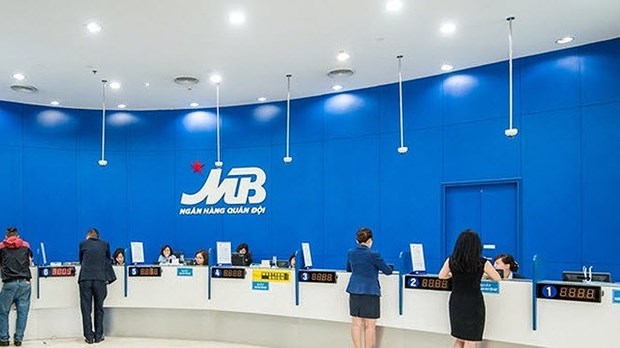 Economy
Economy


|
| A view of an MB office in Hà Nội. MB could be allowed to expand its credit room to about 25 per cent in 2022. VNA/VNS Photo |
HÀ NỘI — Some qualified commercial banks are forecast to get higher credit growth quotas from the State Bank of Việt Nam (SBV) in the next few months.
According to the Bảo Việt Securities Company (BVSC), the SBV is expected to announce a credit expansion for commercial banks at the end of Q3 2022 or at the beginning of Q4 2022 as most banks have so far used up most of their assigned credit quota.
However, as the SBV has so far decided to keep the credit growth target unchanged at 14 per cent in 2022, the selection of banks to get a higher credit growth quota in the remaining months of this year will be tightened.
According to the SBV’s rules, the granting of credit growth quota will be based on the asset quality and operation scale of each bank according to Circular 52/2018/TT-NHNN. Specifically, the SBV will rank banks according to six criteria, including capital, asset quality, governance, business performance results, liquidity and sensitivity to market risks.
The SBV will also consider a number of other criteria related to the banks’ implementation in meeting policies and orientations of the Government and the SBV, such as reducing lending interest rates to support firms and people, focusing loans on business and production, and participating in supporting the handling of weak banks.
According to the criteria, MB, Vietcombank, VietinBank, BIDV and Agribank are forecast to get higher credit expansion than others in the next quota allocation as the banks were the strongest supporters of the economy during the COVID-19 pandemic.
In addition, MB and Vietcombank are also participating in restructuring weak banks in the form of mandatory transfer. Therefore, the two banks will get higher credit growth quota not only in H2 2022, but also in the following years.
MB has been implementing a plan to receive a mandatory transfer of OceanBank. The bank’s vice chairman Lưu Trung Thái said the cooperation with OceanBank is both a political task and an opportunity for MB to expand its operational scale. MB will coordinate with OceanBank to check their data system before developing a plan to submit to the Government.
Meanwhile, Vietcombank is also working on a mandatory transfer of Construction Bank (CB).
Meeting the SBV’s criteria, BVSC estimates Vietcombank can be allowed to expand its credit room to about 19 per cent in 2022, while the number for MB will be about 25 per cent.
Besides the above banks, VPBank can also get a higher credit quota as the bank has considered a plan to receive a mandatory transfer of a weak bank.
After a period of overheating growth which caused interest rates and inflation to accelerate in Việt Nam, the SBV decided to grant an annual credit growth quota for each bank to control the credit growth ceiling in 2011. Currently, very few countries in the world still use a credit growth granting tool like Việt Nam.
According to experts, removing the credit growth limit is necessary, but not immediately, and should be placed on a roadmap. For instance, the SBV announces within five years it will remove the credit limit. During these five years, the SBV will tell commercial banks how to do a stress test and solve the bank's weaknesses, and deal with weak banks as well, with regulations on checking data and responsibilities. If there is no specific schedule set, no bank will do it.
Instead of controlling the credit growth ceiling, the SBV should control credit growth through capital standards according to Basel, combined with modern banking management tools such as periodic checks. This still creates a credit limit for banks, but on a more quantitative, objective and transparent basis.
Dr Cấn Văn Lực, member of the National Financial and Monetary Policy Advisory Council, told Việt Nam News that the SBV should remove the mechanism of granting credit room and managing credit growth through the capital adequacy ratio of banks.
“This credit limit granting mechanism should only be a temporary solution for the next one or two years,” Lực said.
According to the latest data released by the SBV, credit growth of the entire banking system as of July 26 reached 9.42 per cent. With a credit growth target of 14 per cent in 2022, credit can increase by nearly 4.6 per cent in the last five months of this year, equivalent to about VNĐ478 trillion. — VNS




